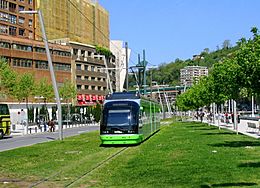Tramway track facts for kids
Tramway tracks are special paths for trams and light rail vehicles. They are like roads for trams! Just like regular train tracks, tram tracks have two parallel steel rails. These rails guide the tram wheels and help the tram move smoothly.
Trams are a cool way to travel in cities. Their tracks are designed to fit into busy streets or even grassy areas. This makes them different from big train tracks you might see in the countryside.
Contents
What Are Tram Tracks Made Of?
Tram tracks are usually made from strong steel. This steel is shaped into special rails. There are two main types of rails used for trams.
Grooved Rails for City Streets
One type is called a grooved rail or girder rail. These rails have a special "groove" or channel built into them. This groove is important because it lets the tram's wheel flange (the part that keeps the wheel on the track) run inside the rail. This way, the top of the rail can be almost flat with the street surface.
This design is perfect for "street-running." Street-running means the tram tracks are laid right into the pavement of city streets. Cars, bikes, and people can move over the tracks without much trouble. It helps trams share the road safely with other traffic.
Standard Rails for Separate Paths
Sometimes, trams use standard rails. These are more like the rails you see on regular railway tracks. They are often placed on sleepers (which are like wooden or concrete blocks) and then covered with ballast (small stones). This type of track is usually found where trams have their own separate path, away from cars. This can be in parks, along rivers, or in special reserved lanes.
Where Do Tram Tracks Go?
Tram tracks can be placed in many different surfaces. Their design allows them to fit into various urban environments.
Tracks in the Street
The most common place to see tram tracks is in the middle of city streets. Here, the grooved rails are often set into concrete or asphalt pavement. This makes the tracks blend in with the road. It allows trams to run alongside cars and other vehicles. This setup is very common in many European cities.
Green Tracks in Grass
An interesting and environmentally-friendly way to lay tram tracks is in grass. This is called grassed track or "track in a lawn". Instead of pavement, the tracks are surrounded by turf. This makes the tram lines look greener and more natural. It can also help reduce noise from the trams. The first grassed track was used in Liverpool, England, way back in 1924! It's a beautiful way to integrate public transport into green spaces.
Tracks on Bridges and Tunnels
Just like trains, trams sometimes need to cross rivers or go under busy areas. So, you might find tram tracks on special bridges or even in tunnels. These sections are built to support the weight of the trams and keep them moving safely.


